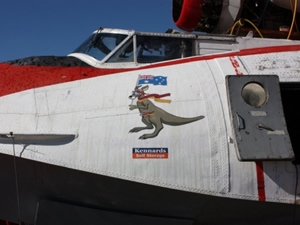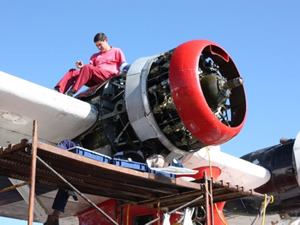



STOP PRESS!
We have been contacted by James Walruff, of 1904 Meadlowlark Drive, Raymore, MO 64083, Missouri, USA, who has kindly provided us with some fresh and invaluable information about our Catalina.
James informs us that:
In late 1945 I was in Patrol Bombing Squadron 62 (VPB 62) based at Whidbey Island, Washington State. About that time the squadron received new PBY-6As, replacing our old PBY-5As. I was in crew No. 1 and 46665 was assigned to us. I flew in her for most of a year. We rotated to the Aleutian Islands during this time [and] flew through the island chain from Kodiak to Attu, as well as to Nome and up the Bering Straits to Point Barrow. Attached is a copy of my flight log for the last two months I was there, which indicates many of the places the plane took us. I was discharged a few months after returning to Whidbey Island.
HISTORY OF VH-CAT
Our PBY6A Catalina is now registered as VH-CAT. Her history makes for interesting reading.
She started life during the final months of the Second World War as serial number 46665, rolling off the Consolidated-Vultee production line in New Orleans as part of an order for the US Navy. The naval air arm accepted her on 22 March 1945 and she was delivered three days later.
She flew with the US Navy as BuAer 46665 until March 1947, mainly in the Aleutians and Alaska. Following an overhaul in May 1948, she was assigned to Norfolk, Virginia, and was later dispatched to a squadron engaged in submarine warfare trials near Key West, Florida. The next significant event in her career occurred in March 1951 when, after another overhaul, she was involved in a ‘Category C’ mishap at a naval base in Chincoteague, Virginia. Apparently, her brakes failed while taxiing and she hit a parked Grumman TBM-3E Avenger.
On 29 March 1953, she was placed in storage at Litchfield Park, Arizona, having accumulated 2512 flying hours. She was removed from the naval inventory in August 1956 and given the US civil registration number N9555C.
In 1957, she turned up on the Chilean civil aircraft register as CC-CNG. The registered owner was an outfit called TRANSA, who mothballed her until 1959, when she was acquired by the prominent Chilean aviator Commandante Roberto Parrague, becoming CC-CNP in the process. Parrague owned a company called ASPAR, and he christened CC-CNP Manutara II in honour of a previous Catalina that he had flown from Chile to Easter Island in 1951.
Manutara means ‘frigate bird’, incidentally.
By coincidence, PG Taylor – the famous Australian flyer – had stopped over on Easter Island soon after Parrague’s visit in 1951. PG noticed a derelict Catalina called Manutara marooned on the island, but he did not realise the significance of the plane at the time and flew on to his destination, Valparaiso, without giving the matter much thought.
It seems that when Parrague was getting ready to fly Manutara back to Chile, the Easter Islanders had warned him that according to legend, their sacred frigate bird would never leave the island. And so it came to pass that as Parrague took off, rough conditions snapped the Catalina’s wing, causing her to ‘die’ on the island as prophesied. Her broken body was still there at the time of PG Taylor’s stop over.
When PG saw the wreck he was glad that he had equipped his own Catalina, the serendipitously named Frigate Bird II, with JATO (jet assisted take-off).
PG, with so many Pacific crossings under his belt, had the greatest respect for frigate birds – an appreciation that he clearly shared with Parrague. He admired the way in which the birds inhabited vast expanses of the ocean, forever skimming the wave tops and seeming never to rest.
As a reward for completing their pioneering flight from Sydney to Valparaiso in ‘51, all PG’s crew were made honorary officers of the Chilean Air force, while PG was awarded a government decoration, Al Merito Bernardo O’Higgins (named after the founder of the Chilean Republic). He also met Parrague, learning the story of Manutara’s ill-fated takeoff from Easter Island.
In 1961, Parrague flew CG-CNP (alias Manutara II) to Easter Island and, four years later, took her on a long-distance flight to Tahiti. But she was used mainly to ferry freight and passengers to and from the Juan Fernandez Archipelago. Parrague’s company ASPAR diversified into the firefighting business during the late ‘60s and CC-CNP was sent from Santiago to Canada to be converted into a fire bomber fitted with internal water tanks and ‘drop doors’. In this new role, CC-CNP was first given the tanker number '65' but later became '35'.
CC-CNP flew to Spain in July 1988 when ASPAR was awarded a firefighting contract there. She worked for the Spanish government department ICONA under a charter arrangement and was re-registered EC-593. This change was short lived, however: by the end of the decade, her Chilean registration of CC-CNP had been restored. She was now working as a chartered fire bomber in Portugal for Aerocondor, which was owned by Victor de Brito.
By this stage, CC-CNP’s firefighting technology had been rendered out of date due to the advent of more efficient, special-purpose Canadian CL415 aircraft. She was retired from service and stored at Seia in the Portuguese Sierras, where she waited patiently for the Catalina Veterans of Rathmines in Australia to save her from laying one sacred frigate birdegg and dying.
She will be reverting to the role to which she was born, that of a Black Cat, but while she is now registered in Australia as VH-CAT she will always keep her avian personal name, Manutara II.